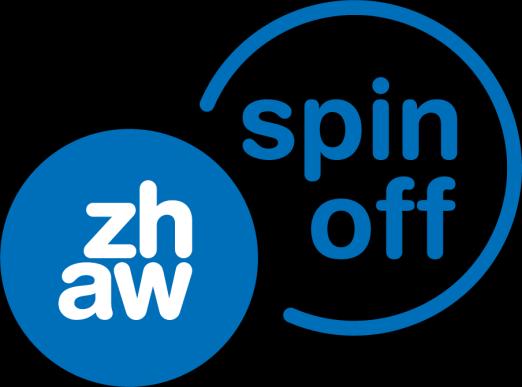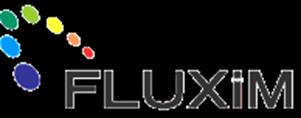
8 minute read
5 Startup Culture at ICP
5 Startup Culture at the ICP
Over the years, several spin-off companies have been established at the ICP. They do not yet carry the newly created ZHAW spin-off logo, but the ZHAW Transfer Office confirmed that the university does support the subsequent assignment of the label. This already describes an initial characteristic of ICP spin-offs: they did not come about through a "top-down" initiative but were created "bottom-up" as a by-product of successful and application-oriented research projects. We believe that it is no coincidence that our institute attracts and supports potential company founders, and we recognize a positive impact on the research projects: Spinoff companies are often good research partners and sometimes effective door openers for EU projects. ZHAW has also recognized the potential of spin-off companies. This year's Department Day at the School of Engineering was dedicated to this topic: Two keynotes [1,2] presented experiences from other universities, and the knowledge gained from these lectures was further explored in small discussion groups. The event was successful in sensitizing the management to the importance of spin-off companies. I am personally connected to this topic, since I myself dared to take the step 15 years ago and gave up my secure employment in a research institute. Together with a small team I placed the results of a research project as a product on the market. In addition to the technical implementation, the transfer of ideas into a startup company requires the successful financing and introduction of the products to the market. However, at the ICP we do not have a strong background in finance or marketing. The candidates bring these skills with them or obtain them in events that are directly addressed to the founders. What we can offer at the ICP corresponds to what Eliav Haskal summarized in his presentation with the following keywords [1]:
Advertisement
Creativity + Innovation + Risk Culture + Empowerment
Creativity and Innovation These are the natural strengths of an engineering school. Projects start with creative ideas, and real innovation occurs when projects are being developed and researchers stay on until someone benefits from the research results. Creativity and innovation are also well represented in teaching at our school, especially in the project track, in some internships and of course in the project and bachelor theses.
Risk Culture and Empowerment A conscious handling of chances and risks is an additional factor in the promotion of entrepreneurial thinking. Something may also go wrong. Even during a project or bachelor thesis, learning from mistakes is more important than reproducing a hidden sample solution. Empowerment goes a little further and characterizes the decision-making structures that promote entrepreneurial spirit. Those who are allowed to participate in decision making and realize that their opinion is worth something, train their independent thinking. This is not always just fun, because you are also held accountable. But researchers that think like entrepreneurs can develop best when their thinking is rewarded.
Support in the startup process is important, especially for young founders. This is not only about knowledge transfer, but also about innovative researchers recognizing their development possibilities and potential. This requires role models and a relaxed atmosphere. A culture of creative coffee breaks will certainly help.
A fair amount of funding is available for institutional startup support. In most cases, founders therefore have an extensive selection of consultants and in some situations need to be careful that the various coaching processes do not have negative effects and become a “waste of time”. Nobody is against spin-offs, but there are organizational forms that weaken entrepreneurship and other structures that strengthen it. In an environment in which everyone prefers to take precautions rather than take responsibility, startup companies rarely emerge. Exaggerated administrative processes inhibit the entrepreneurial spirit (but may motivate taking the step into independence). Those who appreciate the security of well-described processes may prefer to stay on the side of university research.
Not every successful innovation finds its implementation through a startup company. Especially in classical projects at universities of applied sciences, the industry partner implements the research results. Both incremental improvements and groundbreaking innovations can often be implemented more easily in a functioning business. If existing customers can be successfully addressed, the barriers to entry for a new product are many times lower than for the market entry of a newcomer. An interesting result from the discussions at the School of Engineering: The inspiration that emanates from the spin-off idea can be used as a motivating and activating element in teaching. If it is possible to put the learning objectives into the narrative of a company foundation, this has a positive effect on the cooperation among the students and ultimately on the learning success. Expectations must be set realistically: A spin-off idea is rarely born from the lecture exercise of a module in the bachelor's program. But to support innovative thinking, the spin-off idea is valuable. The following pages describe the companies that have been created at the ICP. Not all of them survived, but all of them tried and with all of them we made common projects. Of course, it is a disappointment when a company does not make it. It is important that investors and founders also count on this possibility. And as a university partner it is just as important to think about this eventuality. In such a situation, in well-established partnerships the core know-how can often live on and be used in further research activities.
Several of our current research topics have the potential for commercial exploitation. In addition, a good team of founders is needed, because sometimes innovation and implementation strength in the free market are not united in one person, so that a startup can only fly with a good team constellation. There are several other contact points within ZHAW [3] and we are happy to use our personal networks. We look forward to seeing it happen again in the future and to continuing to support innovative students or employees in taking the step towards independence. Andreas Witzig, Head of ICP
References:
[1] Eliav Haskal, Wie kann man eine Innovations- und Entrepreneurship-Kultur innerhalb einer Forschungsorganisation entwickeln? Invited talk at the Department Day of the School of Engineering, 17.1.2020, Winterthur [2] Patrick Link, Smart-up – Ideen erfolgreich umsetzen. Invited talk at the Department Day of the School of Engineering, 17.1.2020, Winterthur [3] Entrepreneurship@ZHAW, Runway Incubator, Startup Challenge
ICP Spin-Off Companies
www.nmtec.ch Numerical Modelling GmbH works in the field of Computer Aided Engineering (CAE) and offers services and simulation tools for small and medium enterprises. Our core competence is knowledge transfer where we bridge the gap between scientific know-how and its application in the industry. With our knowledge from physics, chemistry and the engineering sciences we are able to support your product development cycle and to conform to your time and budget constraints. We often create so-called customer specific CAE tools in which the scientific knowledge required for your product is embedded. In this form, it is easily deployed within your R&D department and supports actual projects as well as improving the skills of your staff. Ask for our individual consulting service which covers all areas of scientific knowledge transfer without obligation.

www.fluxim.com Fluxim is a provider of device simulation software and measurement hardware to the display, lighting and photovoltaics community worldwide. Our principal activity is the development and the marketing of the simulation software packages SETFOS and LAOSS, as well as the measurement platform PAIOS, PHELOS and LITOS. The combination of simulation software with measurement data allows for the determination of material and device parameters. The R&D tools are used worldwide in industrial and academic research labs for the development of devices and semiconducting materials with improved performance as well as the study of device physics.

www.coatmaster.ch Coatmaster AG (formerly known as Winterthur Instruments) develops measurement systems for fast non-contact and non-destructive testing of industrial coatings. These measurement systems can be used to determine coating thicknesses, material parameters, e. g. porosity and contact quality, e. g. to detect delamination. The system is based on optical-thermal measurements and works with all types of coating and substrate materials. Our measurement systems provide the unique opportunity of non-contact and non-destructive testing of arbitrary coatings on substrates.

Dermolockin GmbH has developed a method to support dermatological examinations based on active thermography. An important field of application was the diagnosis of skin cancer. Unfortunately, the company had to close down its business in 2019. Due to the close cooperation between the ICP and the spin-off company, essential parts of the know-how can still be used for research.

www.nanolockin.com
NanoLockin is developing the new benchmark technology for the detection and analysis of nanoparticles in all kinds of products. The company won the Fribourg Innovation Award in 2018.
www.skinobi.com Opus Néoi is a spin-off company founded in 2016 developing Skinobi, the first reliable skin sensor for end consumers. Skinobi allows the customer to monitor the skin condition at home and recommends the ideal, customized skin care solution. It takes advantage of sophisticated algorithms via an IoT network to analyze and extract skin parameters. The innovative measurement method specifically measures the thermal transport characteristics of the skin by optical means. Thermal conductivity, heat capacity or density are very good markers of the skin’s condition and correlate with physiological parameters like hydration or epidermal thickness.
www.zarawind.com Zarawind is a ZHAW spin-off based in Winterthur, Switzerland, which is involved in the development of a wind energy turbine suspended in the air. The goal of the company is to develop renewable energy sources that are still unused today. Zarawind's technology aims to produce renewable and cost-effective electricity from high altitude, strong and consistent wind power. This can be achieved by a rotor that is lifted to several hundred meters above ground by an aerostat. Wind power is a strong, constantly available energy source. The Zarawind concept ensures continuous operation and prevents noise problems, flickering light reflections and bird collisions. It is also suitable for off-grid regions and produces electricity at low cost.
www.reorbis.com
Reorbis GmbH, based in Winterthur, Switzerland, aims to provide services for the manufacturing industry in the form of life cycle analysis (LCA). In the aluminium industry there is great interest in LCA due to a new standard (Aluminium Stewardship Initiative, ASI). The offer is directed first and foremost towards achieving certification to the ASI standard. The recycling management is applied to other raw materials besides aluminium.







